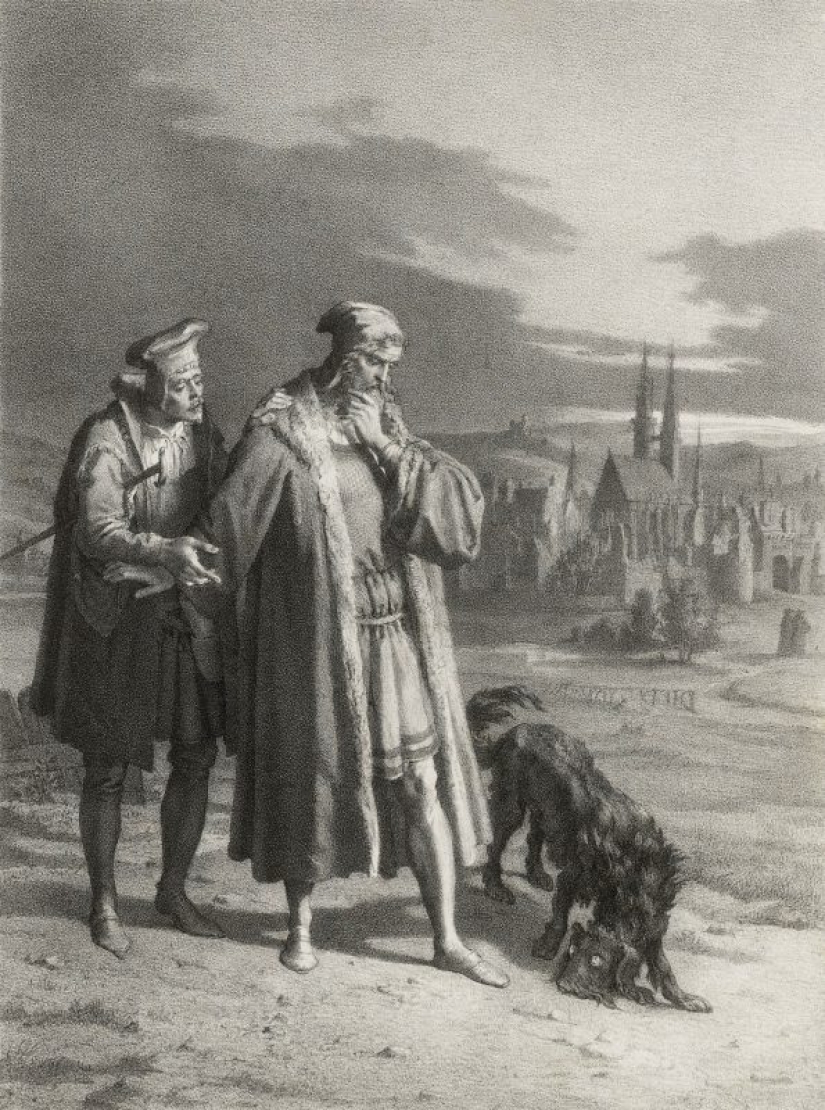The unchildlike secret of the "Golden Key", or Why Malvina had blue hair
Categories: Children | Culture | History
By Pictolic https://pictolic.com/article/the-unchildlike-secret-of-the-golden-key-or-why-malvina-had-blue-hair.htmlThe fairy tale "The Golden Key, or the Adventures of Pinocchio" is probably familiar to everyone. Moreover, everyone knows that the plot of this story, written by Alexey Tolstoy, was based on the story of Carlo Collodi "Pinocchio, or the Adventures of a Wooden Doll" and the writer never hid this. What secrets can there be here? But it turns out that the story of the wooden boy and his friends keeps a lot of secrets, including quite creepy ones.

In the preface to his fairy tale, Alexey Tolstoy wrote that as a child he read the book by Carlo Collodi and it made an indelible impression on him. He repeatedly told his friends the story of Pinocchio, since the book itself was lost. Of course, each time the narrator departed from the original plot and as a result, a new fairy tale was born, which everyone knows as "The Golden Key, or The Adventures of Pinocchio".

It turns out that Tolstoy was lying and everything was completely different. Let's start with the fact that the first edition of "Pinocchio" in Russian appeared when the writer was already 23 years old. Tolstoy did not know Italian either as a child or at a more mature age, so he could not read the book in the original.
The creator of Pinocchio, like many in those years, knew French, and the book was translated into this language repeatedly. But Tolstoy himself repeatedly recalled that there were no children's books in the house where he grew up, so this option completely disappears.
So, Tolstoy read a fairy tale about Pinocchio, being quite an adult. But what touched the young nobleman so much in this story that he decided to write his own version of the adventures of a wooden boy? The answer to this question can be found by looking into the writer's childhood years.

Illustration by Roberto Innocenti
The fact is that Alexey was the unloved son of his father, Count Nikolai Tolstoy. Moreover, there is unconfirmed information that he was not related to him. Most likely, this is why the boy was named Bostrom until the age of 16 and was brought up in his uncle's house. In addition, the biographers of the writer claim that Nikolai Tolstoy did not want to give Alexey his last name and title for a long time.
It is not surprising that the touching story of a rootless wooden boy who struggled to become a man found a lively response in the soul of the unfortunate young man. And he rewrote the fairy tale not because he forgot the details, but for a completely different reason.
In the fairy tale about Pinocchio, written by an Italian author, Malvina was not there. But there was another character with blue hair-this is a fairy. But initially, this minor heroine was not even a fairy, but... a ghost. Collodi had two versions of the story of the wooden boy, and the first, from the point of view of a modern person, is absolutely not childish.
In the first edition of the fairy tale, Pinocchio was supposed to die at the end of the fairy tale. According to the author's plan, he was running away through the forest from robbers and his strength almost left him. But ahead, in the thicket, a small white house appeared, seeing which the hero thought that he could find salvation there.

Illustration by Roberto Innocenti
The boy bangs on the locked doors for a long time, but no one opens it for him. Looking out of the window, Pinocchio sees a strange girl:
After that, the robbers arrived at the house and dealt with Pinocchio. Now such a finale of a children's fairy tale seems more than strange, but in the middle of the XIX century, when the book was written, such a conclusion was quite ordinary and did not shock anyone.

It is possible that everything ended with the death of Pinocchio, but his adventures were so liked by readers that Collodi was forced to turn a dead girl with blue hair into a good fairy who revived him in the next version of the fairy tale. The author did not change the appearance of the character, since it completely corresponded to the image of a mystical creature.
There are many interpretations of the name Malvin. The most common variant is that it means "gentle". But in fact, it's just the opposite. In classical literature, this female name is found for the first time in the work of the Scottish romantic poet James MacPherson "The Poems of Ossian".
Ossian is a legendary British bard who lived around the third century AD. MacPherson's poems were written in the name of this person. According to legends, the hero had a son, whose wife was named Malvina. When the son tragically died, the daughter-in-law remained in his ancestral home, becoming an elderly and infirm Ossian's daughter and assistant.
The bard Ossian with his daughter-in-law Malvina
In Russia, the "Poems of Ossian" were incredibly popular in the first half of the XIX century. This work had a significant impact on the work of Zhukovsky, Batyushkov and even Pushkin. In the poems and poems of these authors, the name Malvin occurs repeatedly.
There are very few translation options for the name Malvin-most philologists are sure that it is based on two ancient Germanic words that are rooted in modern English: "male" (man) "win" (victory). Such a name is very well suited to an overbearing girl who locks naughty boys in a closet.
Collodi, who obviously liked to kill characters, also dealt with the fairy who saved Pinocchio. In the fairy tale, she dies of chagrin that the wooden boy left her. However, after a while they meet again, but the fairy with blue hair is no longer a girl, but a fully grown woman.

Illustration by Greg Hildebrandt
The Italian storyteller deals not only with boys and fairies. In his book, even a cricket is killed, which Pinocchio himself kills with a hammer. But we will not consider Collodi's work from the point of view of psychology and will return to our heroine.
Malvina's lifestyle deserves the closest attention. The girl from Tolstoy's fairy tale lives in the forest and insects, mice and toads obey her. In addition, she has a black poodle with her, which can be found in the most famous work about evil spirits — Goethe's "Faust". It was in the form of a black poodle that the lord of Darkness Mephistopheles appeared to Faust.

Given all this, we can conclude that the girl with blue hair is directly related to the evil spirit. A kind of European Baba Yaga in her youth or a priestess of some not too pleasant pagan cult. It can be argued with a high degree of probability that Tolstoy's Malvina is a fairy, just veiled.
Although Malvina is associated with the occult and magic, it is unlikely that Tolstoy, when inventing this girl, relied on the image of some fairy constantly dying and resurrecting. The secret of the girl with blue hair is directly related to the very golden key and the closet that it unlocks.
Alexey Tolstoy began work on the fairy tale "The Golden Key, or The Adventures of Pinocchio" in exile, longing for Russia and longing to return to his homeland. In the world created by him, the key opens the door, behind which there is a wonderful fair world in which the puppet theater belongs not to miroed Karabas-Barabas, but to the puppets themselves who work in it.

We can say that through a magic door behind a hearth painted on canvas, the heroes of the fairy tale get from the capitalist society of exploiters to Soviet Russia, that is, to the place that Tolstoy so idealized while he was in a foreign land. But why did the writer choose such a strange way of moving from the old world to the bright future?
Carlo Collodi's fireplace in old Geppetto's closet is simply painted on the wall, and Tolstoy — on canvas. It turns out that the door was somehow draped with a cloth with the image of fire. This is a very important moment in history, which we will have to return to later.

Does anyone have any doubts that Tolstoy read "Alice", which was published in the same magazine as his children's stories? There is no doubt that I have not only read, but also used it when working on my fairy tale. An attentive reader may recall that a cloud in the form of a cat's head floated over Malvina's house, at which Artemon the poodle growled. What is not the image of the Cheshire cat, borrowed from Carroll?
In the issue of the magazine" Path", where the Cheshire cat appears for the first time in the history of the girl Alice, Alexey Tolstoy publishes his story about a dog called"Polkan". Thus, the first meeting of a wonderful cat and a dog took place outside the pages of the fairy tale about Pinocchio.

The two girls from the fairy tale of Lewis Carroll and Alexey Tolstoy are undoubtedly similar. Alice is upset by the chaos reigning in Wonderland, and she is constantly trying to restore order there. Malvina is also a supporter of order, cleanliness and discipline, which she is trying to instill in her new friend Pinocchio. At the same time, Alice participates in a tea party with the Mad Hatter and the March Hare, and Malvina herself arranges gatherings with tea for Pinocchio.

Incredibly, in order for the fairy tale about Pinocchio to be born, different images and storylines, mystical heroes and their own childhood experiences had to be miraculously intertwined in the author's imagination. We have considered only Malvina, but there are no less colorful characters in this story, worthy of attention, for example, Karabas-Barabas and Duremar. What secrets are hidden by these characters, clearly not just born of the writer's imagination?
If you were struck by the mysticism in the story of a girl with blue hair, then no less interesting will be 4 more stories of heroes of famous fairy tales that have an otherworldly origin.
Keywords: Witch | Stories | Literature | Mysticism | Writer | Fairy tale | Tolstoy
Post News ArticleRecent articles

American Alex Greenberg, who moved to China, collects funny and brain-bearing examples of Chinese fashion in his Shanghai Observed ...

New Year is a holiday of magic and fulfillment of wishes. Naturally, I want this holiday to be remembered for a long time and to be ...
Related articles

No wonder long hair has been considered a woman's adornment for many centuries. Girls with luxurious curls attract attention and ...

The formation of Russian names occurred centuries under the influence of many factors and cultures. Despite this, our imenoslov ...

American writer Margaret Mitchell wrote only one novel — "gone with the wind". But it provided the woman's place in the ...

In a recent issue of sexual harassment on everyone's lips. Inappropriate and Intrusive signs of attention began to see around, even ...